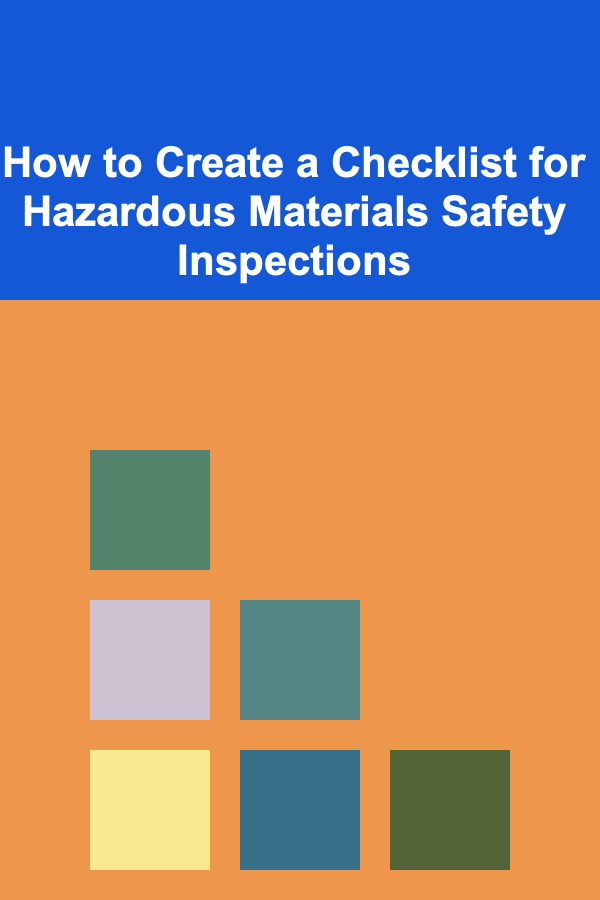
How to Create a Checklist for Hazardous Materials Safety Inspections
ebook include PDF & Audio bundle (Micro Guide)
$12.99$6.99
Limited Time Offer! Order within the next:

Hazardous materials safety inspections are critical to maintaining a safe workplace environment, particularly in industries such as manufacturing, construction, laboratories, and chemical processing. A well-structured checklist for hazardous materials safety inspections not only ensures compliance with regulations but also minimizes the risk of accidents, injuries, and environmental damage.
In this comprehensive guide, we will explore how to create an effective checklist for hazardous materials safety inspections. The goal is to help you create a system that streamlines the process, enhances safety protocols, and promotes a culture of proactive risk management.
Understand the Importance of Hazardous Materials Safety Inspections
Before diving into the specifics of creating a checklist, it's essential to understand the role of hazardous materials safety inspections:
- Regulatory Compliance: Various regulations, such as OSHA (Occupational Safety and Health Administration) and EPA (Environmental Protection Agency), require businesses to ensure proper handling, storage, and disposal of hazardous materials.
- Employee Health and Safety: Hazards associated with materials like chemicals, gases, and explosives pose significant risks. Regular safety inspections help prevent accidents and exposure to dangerous substances.
- Environmental Protection: Inadequate handling of hazardous materials can lead to environmental contamination. Inspections ensure proper containment and disposal methods to protect natural resources.
- Risk Mitigation: Inspections identify potential hazards before they escalate into serious issues, reducing the likelihood of costly fines, accidents, and lawsuits.
By incorporating safety inspections into the daily operations of your workplace, you help ensure both compliance and a safer work environment.
Determine the Scope of the Inspection Checklist
The first step in creating a checklist is to determine its scope. Depending on the type of hazardous materials involved and the size of the facility, the checklist will vary. A comprehensive checklist should cover the following:
- Identification of Hazardous Materials: Ensure the list includes all hazardous materials present in the workplace, including chemicals, gases, radioactive substances, and flammable liquids.
- Storage and Handling Areas: Include areas where hazardous materials are stored, used, or disposed of. This might include storage tanks, hazardous material waste areas, laboratories, or production floors.
- Personal Protective Equipment (PPE): Specify the required PPE for workers interacting with hazardous materials.
- Transport and Labeling Requirements: Verify that hazardous materials are properly labeled, classified, and safely transported within the facility.
Consider the Following Categories for Your Checklist:
- Material Identification
- Storage and Handling Protocols
- Personal Protection and Safety Measures
- Emergency Preparedness
- Waste Disposal and Containment
- Regulatory Compliance
Key Components to Include in a Hazardous Materials Safety Inspection Checklist
A well-rounded checklist for hazardous materials safety inspections should focus on several critical areas. Below, we break down the key components you need to incorporate into your checklist.
1. Material Identification and Inventory
Ensure all hazardous materials are correctly identified and inventoried. This step involves tracking:
- Chemical Name/Type: What is the hazardous material?
- Quantity: How much of the hazardous material is on-site?
- Location: Where is each material stored or used?
- Safety Data Sheets (SDS): Are the SDS for each material readily available and up to date?
Having a detailed inventory of hazardous materials helps you monitor usage, track waste disposal, and comply with regulatory requirements.
2. Storage Safety
Improper storage of hazardous materials can lead to leaks, fires, and exposure to toxic substances. Your checklist should ensure that:
- Containers Are Properly Labeled: All containers holding hazardous materials should have clear, accurate labeling, including the material's name, potential hazards, and handling instructions.
- Secure Storage: Hazardous materials should be stored in secure, designated areas, away from incompatible substances. For example, flammable chemicals should be stored separately from oxidizing materials.
- Proper Ventilation: Storage areas should be adequately ventilated to prevent the buildup of fumes or gases.
- Spill Containment: Ensure that spill containment systems (such as trays, dikes, or secondary containment) are in place to prevent leaks from spreading.
3. Handling and Usage Protocols
Proper handling and usage of hazardous materials are key to preventing accidents and ensuring worker safety. Your checklist should verify that:
- Safe Handling Procedures Are Followed: Workers should be trained in proper handling techniques, including how to mix, pour, and store materials safely.
- Correct PPE is Worn: Ensure that the appropriate personal protective equipment (PPE) is worn when handling hazardous materials. This could include gloves, goggles, respirators, aprons, or chemical-resistant clothing.
- Safe Work Practices: Check that all employees follow proper safety protocols, including no eating or drinking in hazardous material areas, proper disposal of waste, and ensuring materials are not exposed to open flames or other sources of ignition.
4. Emergency Preparedness and Response
Emergencies involving hazardous materials, such as spills, leaks, or exposure, must be handled swiftly and effectively. Your checklist should include:
- Emergency Equipment Availability: Ensure that the necessary emergency equipment (such as fire extinguishers, eyewash stations, and spill kits) is readily accessible and functional.
- Emergency Response Plan: Verify that the workplace has a written emergency response plan in place. The plan should outline the steps to take in the event of a spill, fire, or chemical exposure.
- Training: Employees should be trained in emergency response procedures, including how to evacuate the building, neutralize hazards, and use emergency equipment.
5. Waste Disposal and Containment
Improper disposal of hazardous materials can lead to environmental contamination and legal penalties. The checklist should ensure that:
- Proper Waste Segregation: Hazardous waste should be separated from non-hazardous materials and stored in designated containers.
- Labeling and Documentation: Hazardous waste containers should be clearly labeled with the contents and disposal instructions.
- Regular Disposal Procedures: Establish and follow regular schedules for the safe disposal of hazardous waste according to local regulations.
- Waste Containment: Ensure that waste is contained to prevent leaks and spills, and that the area is regularly inspected.
6. Regulatory Compliance
Ensure that your organization is in compliance with local, state, and federal regulations regarding hazardous materials. This includes:
- Environmental Protection Agency (EPA) Standards: Check that hazardous materials are being handled in accordance with EPA regulations.
- Occupational Safety and Health Administration (OSHA) Guidelines: Verify compliance with OSHA's Hazard Communication Standard (HCS) and other relevant guidelines.
- Local Regulations: Stay informed about any specific regulations in your area that might impact how hazardous materials should be handled, stored, or disposed of.
7. Documentation and Record Keeping
Proper documentation is vital for maintaining a safe and compliant workplace. Your checklist should ensure:
- Inspection Records: Maintain records of all safety inspections, including dates, areas inspected, and any issues identified.
- Corrective Actions: Track any corrective actions taken to address identified hazards, ensuring that all problems are resolved promptly.
- Employee Training Logs: Keep records of employee training on hazardous material handling and emergency procedures.
Best Practices for Implementing the Checklist
Creating a comprehensive checklist is only half the battle. To ensure your hazardous materials safety inspections are effective, consider the following best practices:
1. Regular and Scheduled Inspections
Establish a routine schedule for safety inspections. These should be conducted regularly to ensure ongoing compliance and to identify potential risks early. Inspections may be scheduled weekly, monthly, or quarterly depending on the volume of hazardous materials handled and the type of operations.
2. Training Employees on Inspection Procedures
Ensure that employees who are responsible for conducting inspections are trained in both the checklist and the proper techniques for inspecting hazardous materials. Regular refresher courses can help keep employees informed about the latest safety protocols.
3. Involve Multiple Stakeholders
It's essential to involve multiple team members in the inspection process. For example, include managers, safety officers, and employees who directly handle hazardous materials. This promotes a culture of safety and ensures that inspections are comprehensive.
4. Document and Address Hazards Promptly
Once hazards are identified, ensure that they are addressed immediately. Document any findings and corrective actions taken to demonstrate compliance and improve safety continuously.
5. Review and Update the Checklist Regularly
As operations change or new regulations emerge, your checklist should be reviewed and updated. Regularly assess whether the checklist still covers all aspects of hazardous material safety and make adjustments as needed.
Conclusion
Creating a checklist for hazardous materials safety inspections is a crucial step in maintaining a safe and compliant workplace. By covering areas like material identification, storage safety, handling protocols, emergency preparedness, waste disposal, and regulatory compliance, you can help ensure the safety of your employees and the environment.
With a well-structured checklist, regular inspections, and a proactive safety culture, your workplace will be better equipped to handle hazardous materials safely and efficiently, minimizing risks and ensuring compliance with local and federal regulations.

How to Create Effective Marketing Campaigns for Small Businesses
Read More
How to Earn Money by Licensing Deep Learning Algorithms
Read More
How to Install a Home Safe for Added Security
Read More
How to Store and Organize Your Hose and Watering Equipment
Read More
How To Understand Relational Databases vs. NoSQL
Read More
The Best Cheaper Alternatives for Popular Brands Without Sacrificing Style or Performance
Read MoreOther Products

How to Create Effective Marketing Campaigns for Small Businesses
Read More
How to Earn Money by Licensing Deep Learning Algorithms
Read More
How to Install a Home Safe for Added Security
Read More
How to Store and Organize Your Hose and Watering Equipment
Read More
How To Understand Relational Databases vs. NoSQL
Read More